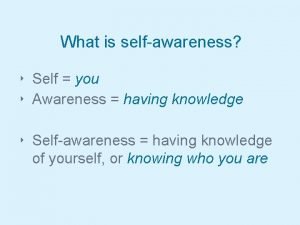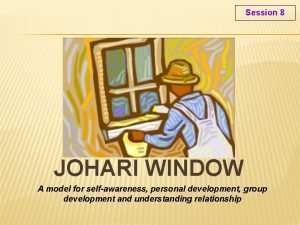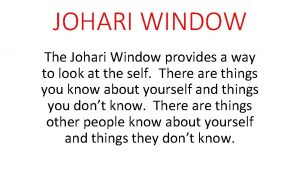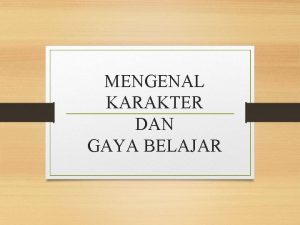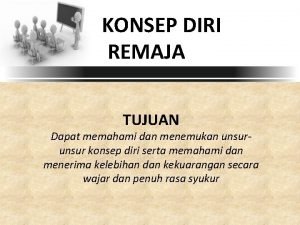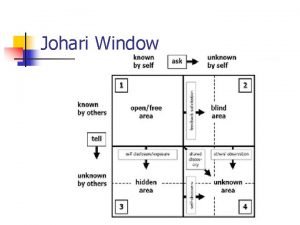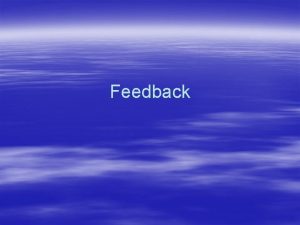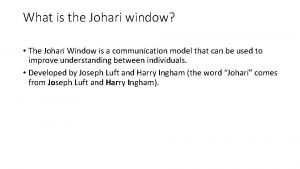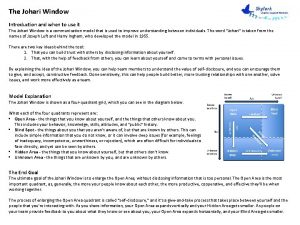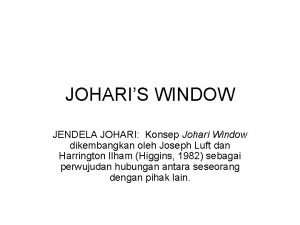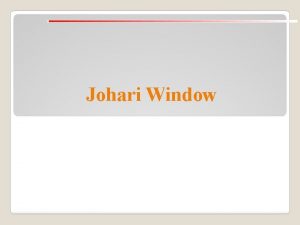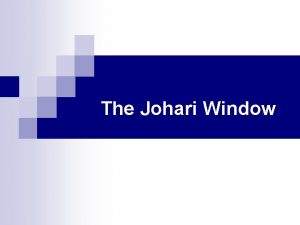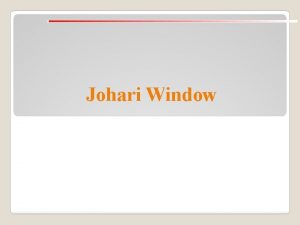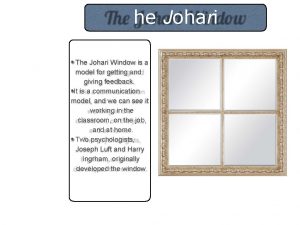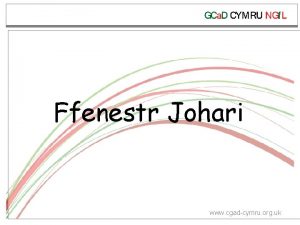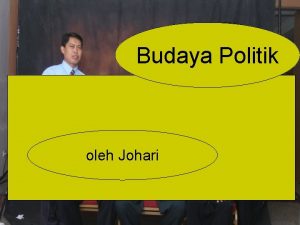Session 8 JOHARI WINDOW A model for selfawareness












- Slides: 12

Session 8 JOHARI WINDOW A model for self-awareness, personal development, group development and understanding relationship

Johari Window Ø Johari window is a symbolic tool. Ø Created in 1955 in United States. Ø By US psychologists JOSEPH LUFT & HARRY INGHAM. Ø Name originates from their names; # JOE + HARRY = JOHARI Ø Used to help people better understand their interpersonal communication and relationships.

Terminology q Refers to 'self' and 'others' 'Others' - other people in the team ‘Self' - oneself, i. e. , the person subject to the Johari Window analysis

The 4 Johari Window Perspectives q Called 'regions' or 'areas' or 'quadrants'. q Each contains and represents the known/unknown information - feelings, motivation, etc. q The four regions, areas, quadrants, or perspectives are popularly known as; - ARENA - BLIND SPOT - FAÇADE - UNKNOWN

Johari Window Four Regions 1. Open area, open self, free area, free self, or ‘the arena’ - what is known by the person about him/herself & is also known by others. 2. Blind area, blind self, or ‘blindspot’ - what is unknown by the person about him/herself but which others know. 3. Hidden area, hidden self, avoided area, avoided self or 'façade’ - what the person knows about him/herself that others do not know. 4. Unknown area or Unknown self - what is unknown by the person about him/herself and is also unknown to others.

Standard Representation ARENA BLIND SPOT FAÇADE UNKNOWN

Increasing open area (ARENA) by reducing Blind Spot q Increasing open area (ARENA) & reducing BLIND SPOT; Ø Solicit Feedback. Ø Develop a receptive attitude. Ø Proactively invite feedback. Ø People should feel comfortable in giving you f/b. Ø The more you know about U, the more you have the open area as a widened ARENA.

Increasing ARENA by reducing hidden area (FAÇADE) q Increasing ARENA by reducing FAÇADE; Ø Giving Feedback. Ø My reactions to group. Ø Disclosing my mind. Ø Making myself transparent - Revealing myself - Perceptions, Feelings, Weakness Ø By doing so, the group knows about me and does not guess things about me. Ø The more they know about me the more I become transparent to them. Blind Spot Arena FF Façade Unknown Area

What to do with the UNKNOWN AREA? ? ? q What could be those areas? Ø Intra-personal dynamics Ø Unconscious Mind Ø Hidden Potentials etc. q Knowing all about oneself is extremely unlikely and impossible. q The UNKNOWN in the model denotes that a part of individual will always remain unknown & unconscious. q BUT, working-out on ARENA through reducing Façade & Blind Spot is the key. Blind Spot Arena FF Façade Unknown Area

MANAGERS AND LEADERS q Facilitating feedback and disclosure among group members. q Promote a culture for; - open, honest, positive, helpful communiqué - sharing knowledge throughout organization. q Encouraging the positive development of the ‘ARENA’ for everyone, which is a fundamental aspect of effective leadership.

JOHARI WINDOW INSTRUMENT

Plotting Your Scores & Interpretation Receptivity to Feedback 0, 0 5 10 15 20 25 30 35 40 45 50 5 15 20 25 30 35 Self Disclosure 10 SCORING OPEN BLIND X. Receptivity to F/B _____ Y. Willingness to SD _____ MASKED 40 45 50 Index of Interpersonal Risk Taking = Xx. Y x 100 50 x 50 UNKNOWN 50, 50
 Why is self-awareness important
Why is self-awareness important Arena facade blind spot unknown
Arena facade blind spot unknown Johari window model
Johari window model Belbin and johari window
Belbin and johari window Kuadran 1 jendela johari
Kuadran 1 jendela johari Konsep diri teori johari windows
Konsep diri teori johari windows Konsep diri
Konsep diri Johari window personality test
Johari window personality test Johari window feedback
Johari window feedback Konsep jendela johari
Konsep jendela johari Joseph luft and harry ingham in 1955
Joseph luft and harry ingham in 1955 Johari window introduction
Johari window introduction Johari window case study example
Johari window case study example
